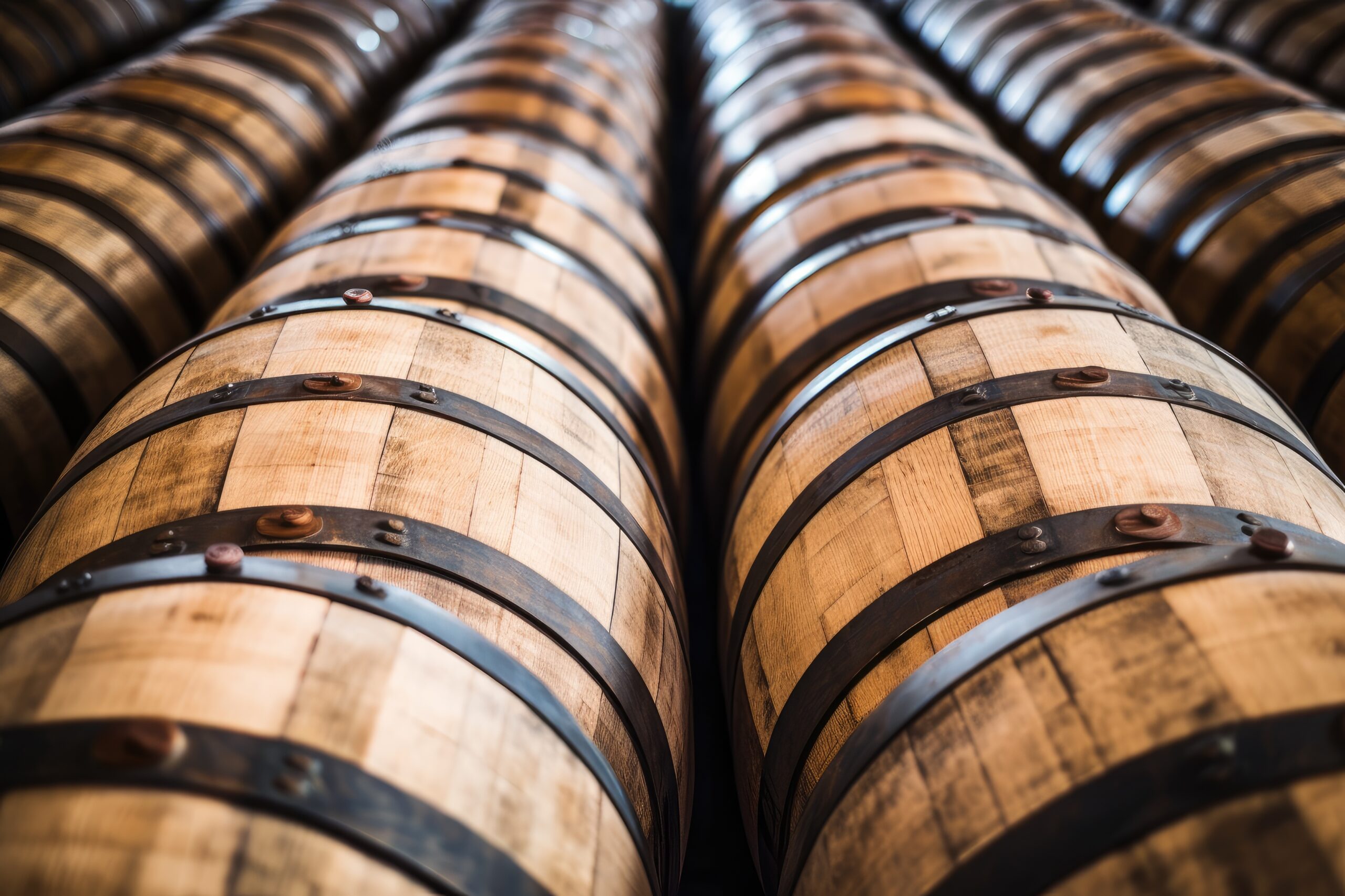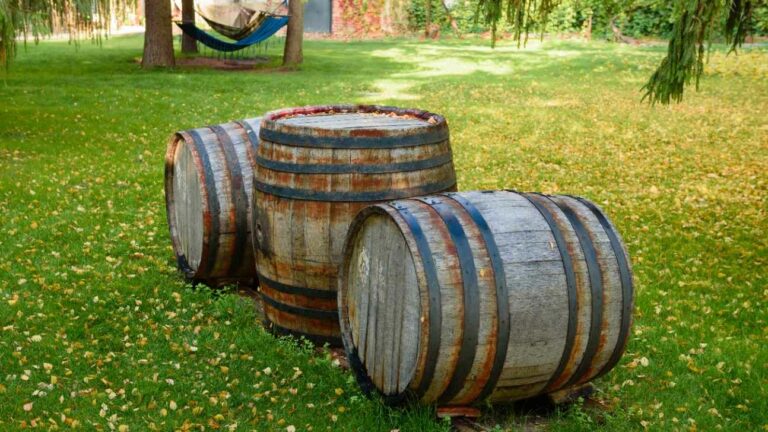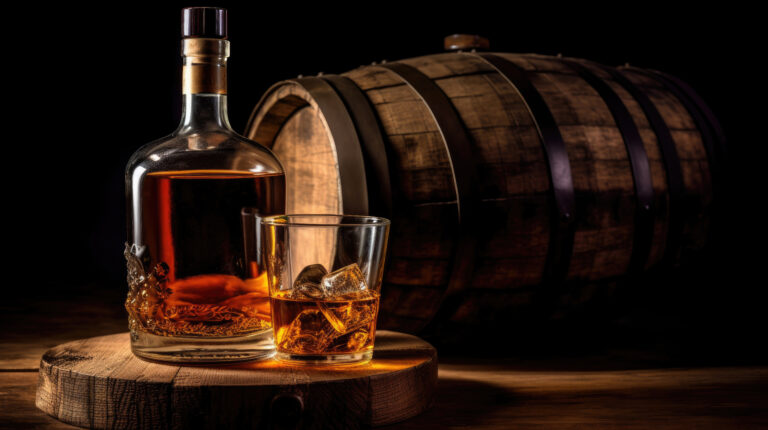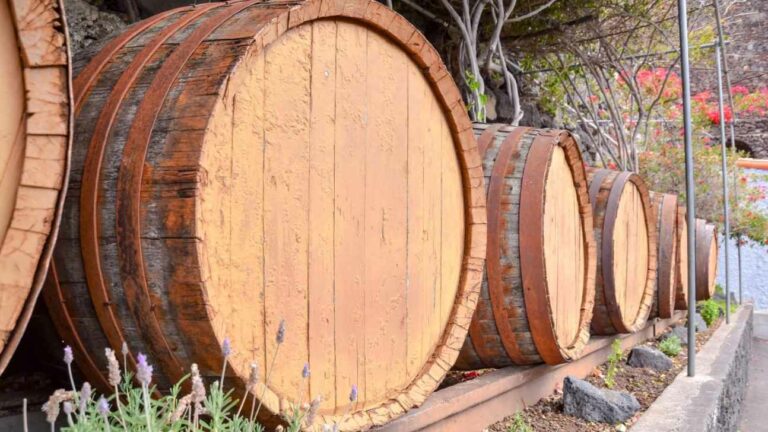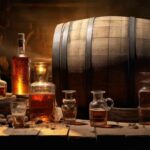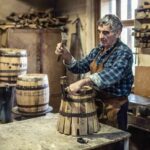Ever sip a whiskey and ponder its rich amber color and those delightful oaky, vanilla notes? The magic lies in barrel aging. For years, as the clear distilled spirit rests within charred oak barrels, a fascinating chemical reaction unfolds, transforming it into the nuanced and smooth drink we cherish. The wood interacts with the whiskey through extraction, infusing it with hundreds of flavor and aroma compounds that conjure hints of caramel, spice, and dried fruit. Simultaneously, oxidation gently occurs as oxygen meets the whiskey, softening the harsher elements from distillation and creating esters that give aged whiskey its signature scent. Barrel aging is truly a blend of art and science, relying on careful barrel selection and precise control of temperature and humidity to craft a premium spirit. Let’s delve into the chemistry of how wood and whiskey unite to create something truly special.
The Science Behind Barrel Aging
The aging of whiskey in charred oak barrels is a captivating chemical process. As the whiskey matures within the barrel, it diligently absorbs compounds from the wood, bestowing upon the aged spirit its characteristic caramel color and inviting flavors of vanilla, nuts, and dried fruit.
The Barrel’s Char
When barrels undergo charring, the intense heat works its magic, breaking down the oak’s lignin and cellulose into smaller, more reactive molecules. This process creates a layer of charcoal that acts as a natural filter, mellowing the whiskey. Intriguingly, this char layer is also rich in carbonyl groups that engage in reactions with whiskey compounds, forming esters that contribute delightful fruity notes.
Extracting Oak Lignins
The whiskey acts as a solvent, dissolving fragments of lignin, the very polymer that provides the barrel’s wood structure. The breakdown products of lignin are particularly interesting, yielding vanillin, the key flavor compound we associate with vanilla, along with coniferyl and sinapyl alcohols, which lend warm notes of cloves and cinnamon.
Toasting the Barrel
The application of heat during barrel toasting also gives rise to furfurals, molecules that impart a subtle almond-like flavor. As the whiskey interacts with the toasted inner layer of the barrel, it diligently picks up these furfurals and other enticing flavorful compounds. The medium char typically favored for bourbon barrels is a sweet spot, maximizing the extraction of these wonderful oak-derived flavors.
Evaporation and Oxygenation
As the whiskey patiently rests, a portion of the ethanol and water gracefully evaporates – a phenomenon poetically known as the “angel’s share.” Simultaneously, oxygen subtly permeates the barrel, engaging in reactions with compounds within the whiskey to form fragrant esters and acetals that contribute both fruity and nutty flavors. The barrel’s char layer plays a crucial role here, helping to filter out any harsher, less desirable oxidation byproducts.
This intricate chemistry between the whiskey and the barrel oak is the very essence of the mellow and complex flavor that gracefully develops over years of aging. While aging demands patience, the reward is undeniable – a taste of a well-aged spirit that truly justifies the wait!
How Wood Impacts Flavor
When whiskey embarks on its aging journey within wooden barrels, the wood profoundly shapes its flavor in truly fascinating ways.
The oak barrels themselves are crafted from staves, thin planks of wood meticulously bent and bound together. As the whiskey matures, it slowly penetrates the wood, diligently extracting aromatic compounds like vanillin that bestow upon the aged spirit its distinctive taste. The process of charring or toasting the inside of the barrel further enriches the flavor profile, contributing appealing smoky and caramelized notes.
The interaction between the whiskey and the wood involves an oxidation reaction that gently breaks down complex tannins into simpler, more palatable flavor compounds. This very process is responsible for the development of the characteristic amber color, as well as the emergence of inviting flavors of vanilla, nuts, and spice. The alcohol and water present in the whiskey act as solvents, gradually dissolving these desirable compounds from the wood over time.
The specific type of oak chosen, whether it be American white oak or European oak, significantly influences the array of flavor compounds the whiskey will acquire. Furthermore, the barrel’s previous usage, whether it once held bourbon, sherry, or port, also leaves its mark on the final flavor. As a barrel is reused, it tends to impart less intense flavor to the subsequent whiskey.
The temperature and humidity within the aging warehouse play a crucial role in dictating the pace at which the whiskey matures. Cooler temperatures lead to a more gradual aging process, while warmer conditions tend to accelerate it. Higher humidity facilitates greater interaction between the whiskey and the wood. Many distilleries strategically experiment with barrel placement within the warehouse to achieve their desired flavor outcomes.
While barrel aging is undoubtedly an art form, it is equally grounded in scientific principles. Understanding the intricate dance between wood and whiskey allows spirit enthusiasts to better appreciate the sublime complexity of a well-aged dram. Sláinte!
The Role of Lignin and Vanillin
The aging of whiskey is a testament to the intricate chemical reactions that occur between the spirit and the barrel. Among the many players in this transformation, lignin and vanillin stand out as particularly significant compounds.
Lignin
Lignin is a complex organic polymer, a fundamental component of the wood used for barrels, especially oak. As the whiskey interacts with the barrel, lignin undergoes a gradual breakdown, releasing compounds that impart delightful vanilla, clove, and even subtle smoky flavors to the spirit. Furthermore, lignin engages in reactions with oxygen and ethanol, producing aromatic aldehydes that contribute appealing fruity and nutty notes.
Vanillin
Vanillin is the star of the vanilla aroma and a major contributor to the overall aroma and flavor profile of aged whiskey. This coveted compound originates from the breakdown of lignin within the barrel staves. As the whiskey ages longer, the concentration of vanillin steadily increases, enriching the spirit with a more pronounced vanilla character. Other related compounds, such as vanillic acid and syringaldehyde, also develop, adding nuanced spicy and smoky undertones.
The degree of char on the inside of the barrel significantly influences the amount of vanillin and other desirable compounds that are imparted to the whiskey. More heavily charred barrels, commonly used for bourbon, tend to yield higher concentrations of vanillin and bolder vanilla flavors. The alcohol in the spirit acts as an efficient solvent, extracting these compounds from the wood, while simultaneously facilitating the evaporation of water and alcohol from the barrel – a process that can lead to an increase in the whiskey’s ABV over time.
As the whiskey matures, the molecules within the spirit undergo a fascinating increase in structural complexity. Hundreds of chemical reactions occur between the compounds drawn from the wood and those originally present in the distilled spirit. This intricate interplay between wood and spirit is the very foundation of the multi-layered aromas and tastes found in well-aged whiskey. While a minimum aging period of two years is required to earn the designation of “whiskey” in the US, many premium brands undergo aging for three years or more to achieve a harmonious symphony of flavors.
The chemistry behind barrel aging is a delicate balancing act, but when all the components come together in perfect harmony, it produces a spirit of unparalleled depth, character, and soul. For whiskey lovers, that first sip of a well-aged dram is truly a revelation in liquid form.
Extracting Color and Flavor From the Barrel
The aging process within whiskey barrels hinges on a complex interplay of chemical reactions between the spirit and the wood. As whiskey patiently rests in the barrel, it diligently absorbs compounds from the wood, acquiring its characteristic color and flavor.
Extracting Lignin and Hemicellulose
Lignin and hemicellulose are key compounds found in oak that gradually break down over time and leach into the whiskey. Lignin is primarily responsible for the gradual browning of the whiskey. Hemicellulose contributes a pleasant nutty, woody aroma. As these compounds dissolve into the spirit, the whiskey takes on a richer, amber hue.
Gaining Natural Caramel Color
The interplay of heat and humidity within the barrel encourages the wood’s natural sugars to undergo caramelization, imparting a delightful sweet caramel flavor and a rich brown color to the whiskey. The longer the whiskey ages, the more caramel it absorbs, leading to a progressively darker appearance.
Developing Tannins
Tannins are naturally occurring compounds found in oak that can initially present a bitter, astringent quality. However, over time, these tannins mellow and gracefully blend with other flavors, providing structure, balance, and a subtle drying sensation to the whiskey. Interestingly, tannins also play a role in the aging process by acting as natural preservatives.
Extracting Spice and Vanilla Notes
Specific compounds known as lactones, particularly vanillin and eugenol, emerge from the barrel to contribute inviting notes of vanilla, clove, and other warm spices. Trace amounts of coconut and almond flavors can also develop. These compounds are highly volatile, meaning they have a significant impact on the overall aroma and flavor profile of the aged whiskey.
Gaining Complexity
Hundreds of additional compounds that originate in the oak, collectively known as congeners, find their way into the whiskey during the aging process. Though present in only minute quantities, these congeners interact in fascinating ways to create a kaleidoscope of smells and tastes in aged whiskey, ranging from fruit and nuts to delicate floral and herbaceous notes. Their intricate alchemy bestows upon aged whiskey an unparalleled depth and complexity of flavor.
Through a slow and steady dialogue between spirit and wood over time, whiskey gains not only color, but also intricate aroma, nuanced taste, and distinct character. The compounds it absorbs create layers of flavor that harmoniously blend into a cohesive whole, crafting a spirit as multi-faceted as the barrel that cradled it.
The Impact of Char and Toasting
The charring and toasting of the oak barrels used in whiskey aging exert a significant influence on the flavor of the final product. As the wood undergoes charring, the cellulose and lignin, the primary structural components of wood, break down into smaller molecules known as phenols. These phenols impart a characteristic smoky, spicy flavor to the whiskey. The level of char is carefully controlled by the duration and intensity of the burning process, ranging from a light toast to a heavy char. More heavily charred barrels, often favored for bourbons, tend to produce more pronounced smoky flavors. Conversely, lighter toasts often lead to subtler, sweeter flavors in whiskeys like scotch.
Phenols
The array of phenols present in charred oak barrels includes vanillin, which contributes a delightful vanilla aroma, and syringaldehyde, which adds intriguing aromas of smoke and spice. As the whiskey ages, these phenols gradually leach from the charred wood into the spirit, profoundly influencing its flavor and aroma. The specific phenols imparted depend on several factors, including the type of oak, its geographical origin, and the level of toasting. American oak, commonly used for bourbon, tends to yield more robust and sweeter flavors compared to the European oak often employed in scotch whiskey aging.
The Maillard Reaction
The application of heat during barrel toasting also triggers the remarkable Maillard reaction, a complex chemical process that generates hundreds of distinct flavor compounds. As amino acids and reducing sugars within the wood break down under the influence of heat, they form these diverse compounds, which contribute inviting aromas of nuts, caramel, chocolate, and even freshly baked bread. The specific compounds created are influenced by the wood type and the intensity of toasting. Heavier toasting generally results in a greater abundance of these Maillard reaction products, leading to richer, nuttier flavors.
Oak Lactones
The toasting process also gives rise to compounds known as oak lactones, which impart characteristic aromas of coconut and warm wood spice. The levels of oak lactones tend to increase with the intensity of toasting and longer aging periods. They are largely responsible for the distinctive oak and coconut aromas often found in well-aged whiskeys.
The chemistry behind barrel toasting and charring is a truly captivating and almost magical transformation. It is remarkable how these seemingly simple elements—wood, heat, and time—can collaborate to transform distilled spirits into the complex and flavorful elixirs we know and love as whiskeys.
The Chemistry of Maturation
As whiskey gracefully ages within barrels, a fascinating and intricate set of chemical reactions unfolds, transforming the raw spirit into a smooth and flavorful drink. These reactions involve not only the compounds present in the wood but also those inherent in the whiskey itself.
Oak Lignins
The wood barrels are typically crafted from oak, a remarkable material composed of lignin, cellulose, and hemicellulose. When the oak is exposed to ethanol, the lignin undergoes a gradual breakdown, yielding vanillin, the primary compound responsible for the delightful vanilla aromas often found in whiskey. This breakdown of lignin also produces other phenolic compounds that contribute warm spicy and subtle smoky flavors.
Oak Tannins
Oak barrels also contain tannins, the same compounds that lend red wine its characteristic bitterness and astringency. In whiskey, these tannins mellow over time, and in carefully balanced amounts, they contribute to the spirit’s structure and mouthfeel. As tannins polymerize, they can precipitate out of the solution, sometimes forming a harmless sediment at the bottom of the barrel.
Extractives
The barrel staves contain a variety of water-soluble extractives, including lactones, fats, and waxes, which gradually dissolve into the whiskey during the aging process. Lactones, in particular, contribute appealing fruity, often coconut-like aromas. The specific variety of oak, the treatment of the barrel, and the surrounding environmental factors all play a role in determining the unique composition of these extractives, making each barrel a truly individual vessel.
Evaporation and Oxidation
As whiskey ages, both water and ethanol slowly evaporate through the porous barrel staves – a phenomenon famously known as the “angel’s share.” This gradual loss of volume leads to a concentration of the remaining flavor compounds, resulting in a more complex and intense spirit. Oxidation also plays a crucial role, as small amounts of oxygen permeate the barrel and react with compounds in the whiskey to form fragrant esters and aldehydes, which contribute inviting dried fruit and nutty flavors.
The chemistry of barrel aging is a complex yet truly magical process. All of these intricate chemical reactions, in concert with the skill of the distiller and the unique character of each barrel, come together to create an exceptional whiskey with a flavor profile all its own. The next time you swirl a glass of well-aged whiskey, take a moment to appreciate the symphony of chemical processes that composed it.
Factors That Influence Maturation Rates
The maturation of whiskey is a dynamic and intricate process involving a multitude of chemical reactions that are influenced by several key factors. These factors determine the pace at which a whiskey develops its characteristic flavor and aroma within the barrel.
Barrel Size
Whiskey tends to age more rapidly in smaller barrels due to the increased surface area contact between the spirit and the wood. The smaller the barrel, the quicker the maturation process. This is why some distilleries strategically utilize smaller barrels to accelerate aging and bring products to market more quickly.
Wood Type
The specific type of wood used for crafting the barrel also significantly impacts maturation rates. Oak barrels, particularly those made from American or French oak, are the standard in whiskey making. American oak is known for imparting more pronounced vanilla and coconut flavors, while French oak tends to contribute spicier notes. The inherent properties of the wood, such as its porosity, directly affect how much whiskey can penetrate into the wood and extract those desirable flavor compounds.
Barrel Char
The degree of char on the inside of the barrel plays a crucial role in accelerating maturation. A heavier char exposes more of the wood’s surface, providing a greater area for the whiskey to interact with. The char also contributes distinct smoky and toasty flavors to the spirit. Generally, a more intense char leads to faster aging.
Barrel Location
The specific location where barrels are stored during maturation significantly influences temperature fluctuations, which, in turn, affect the aging process. Warehouses that experience wider temperature swings, especially warmer temperatures, will generally age whiskey more quickly than cooler, more stable environments. Heat causes the wood staves to expand and contract, allowing the whiskey to penetrate the wood more effectively.
Alcohol Percentage
Spirits with a higher alcohol percentage tend to age faster than those with a lower proof. The higher concentration of alcohol acts as a more efficient solvent, facilitating the extraction of compounds from the wood. Cask strength or barrel proof whiskeys (typically around 50-60% ABV) will generally mature more rapidly than those that have been diluted with water before barreling.
By understanding how these various factors influence maturation, one can gain a deeper appreciation for the nuanced art of whiskey making. It highlights how nature and human intervention combine in the aging process to create the complex and flavorful spirits we enjoy.
Regional Differences in Barrels
The specific type of wood employed in crafting whiskey barrels can exert a profound influence on the ultimate flavor profile of the aged spirit. The most prevalent wood types include American white oak, European oak, and, less commonly, hickory.
American white oak stands as the gold standard for bourbon barrels. It imparts characteristic notes of vanilla, rich caramel, and subtle coconut. Notably, bourbon production is geographically restricted to the United States, and the use of new American white oak barrels is a legal requirement.
European oak, particularly French oak, finds widespread use in the aging of Scotch whisky. It contributes nuanced aromas of dried fruit, such as raisins and prunes, along with warm spices like clove and nutmeg. The tighter grain structure of European oak results in a slower rate of interaction with the spirit.
Some adventurous distillers explore the use of other wood types, such as hickory, to introduce unique flavor dimensions to their finished products. Hickory can lend intriguing hints of pecans, almonds, and even maple syrup. However, it is generally considered more challenging to work with and less porous than oak.
Climate
The prevailing climate in which the barrels are stored also plays a significant role in shaping the aging process. Warmer temperatures tend to accelerate the interaction between the wood and the spirit, while colder temperatures slow it down. Many distilleries strategically utilize a combination of barrel houses with varying temperature profiles to achieve their desired outcomes.
Distilleries in Scotland often employ stone-built barrel houses that maintain a relatively constant and cool temperature. This slower aging process is believed to contribute to the smooth and complex flavor profile often associated with Scotch whisky. In contrast, the hot summers of Kentucky lead to more rapid aging, contributing to the robust vanilla and caramel notes characteristic of bourbon.
Regional Styles
The unique confluence of conditions within a specific region ultimately shapes the distinctive characteristics of both the barrels and the resulting whiskey. Everything from the soil in which the trees are grown to the traditional woodworking techniques of the local coopers and the natural weather patterns contributes to the creation of barrels with individual personalities that, in turn, influence the regional styles of whiskey that we have come to know and appreciate. Understanding the processes of barrel production and aging in different parts of the world provides valuable insight into the subtle nuances that distinguish whiskeys from various regions.
The Chemistry of Whiskey Barrel Aging FAQ
The aging of whiskey within charred oak barrels initiates a fascinating cascade of chemical reactions that bestow upon the spirit its distinctive color and complex flavor. Here are some of the most frequently asked questions regarding the chemistry of barrel aging.
What gives whiskey its brown color?
As whiskey matures within the barrel, various compounds from the charred oak wood gradually leach into the spirit. Lignins, phenols, and tannins are key contributors to the development of its characteristic brown hue. Generally, the longer the whiskey ages, the deeper and richer its color becomes.
How does whiskey get its oak flavor?
Volatile compounds such as vanillin, lactones, and furfural are primarily responsible for the oaky and vanilla notes found in whiskey. As the whiskey slowly extracts these flavor compounds from the barrel wood over time, its taste profile evolves into a smoother and more mellow character.
What’s the difference between bourbon and Scotch?
The type of barrel employed is a crucial distinguishing factor. Bourbon must, by law, be aged in new charred oak barrels, typically crafted from American white oak. In contrast, Scotch is often aged in used barrels, frequently those that previously held bourbon. American oak tends to impart sweeter and spicier flavors compared to European oak. The use of previously filled barrels often contributes more subtle and mellow notes to Scotch.
What causes the whiskey’s aromas?
A complex array of hundreds of volatile compounds contributes to a whiskey’s aroma. Esters often produce fruity smells, while phenols contribute spicy and smoky notes. Whiskey acquires these diverse compounds through the barrel aging process and the Maillard reaction. As the spirit interacts with the wood and oxygen, its aromatic profile becomes increasingly intricate.
Does whiskey age in the bottle?
Once whiskey is removed from the barrel and bottled, the aging process essentially ceases. While the flavor and aroma compounds remain stable within the sealed bottle, they do not undergo significant changes over time. However, whiskey can be susceptible to oxidation if exposed to air, which may lead to undesirable alterations in its character. For optimal quality and longevity, it is best to store bottles sealed and away from excessive heat and light.
The chemistry underpinning whiskey aging is a truly captivating alchemy. Master distillers skillfully blend both scientific understanding and artistic intuition to create spirits with exceptional taste, aroma, and character. A deeper understanding of the chemical reactions at play allows whiskey lovers to appreciate each sip on a more profound level.
Final Thoughts
So, the next time you raise a glass of whiskey to your lips, take a moment to contemplate the intricate chemistry that has contributed to that distinctive flavor you know and love. Barrel aging is truly an art form, where a multitude of variables converge to impart the unique characteristics that define each individual whiskey. Whether your preference leans towards a smoky single malt Scotch or a smooth Kentucky bourbon, every distiller strives to create an experience through aging that will keep you coming back for more. Whiskey is meant to be savored and enjoyed, not merely consumed. Now that you possess a greater understanding of the chemistry behind the aging process, you can fully appreciate all the subtle notes and aromas and perhaps even consider yourself a budding whiskey connoisseur. The next time that amber liquid graces your glass, savor the flavor and raise your glass to the artistry of distillers and the wonders of chemistry.
